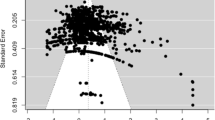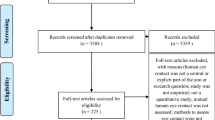Abstract
Preschoolers’ (n = 32) attention to print and pictures was documented during an electronic storybook reading session. Children (M = 51.06 months; SD = 7.34 months) looked at a 12-page book that contained three types of pages, each of which was presented four times over the course of the book: (1) silent presentation of print, (2) print that was read aloud, and (3) print that was both read aloud and highlighted. Our research objectives were to analyze whether the way in which print was presented related to the ways in which children attended to print and pictures during the reading session. Gaze fixation duration to print and pictures was assessed using a Tobii X2-60 portable eye tracking unit, which captured corneal reflection data for each child. Children’s total fixation duration to print was greatest when print was read aloud and highlighted as compared to when it was presented silently or read aloud. In addition, children looked at print more when it was displayed silently than when the computer read the story to children, although this difference was much smaller in magnitude. Children attended to pictures more than print across pages, but this difference was most notable when the story was read aloud. Results demonstrate the potential utility of nonverbal print referencing strategies during book reading.

Similar content being viewed by others
References
Bingham, G. E. (2007). Maternal literacy beliefs and the quality of mother-child book reading interactions: Associations with children’s early literacy development. Early Education and Development, 18, 23–49. doi:10.1080/10409280701274428.
Breit-Smith, A., Justice, L., McGinty, M., & Kaderavek, A. S. (2009). How often and how much? Intensity of print-referencing intervention. Topics in Language Disorders, 29, 360–369. doi:10.1097/tld.0b013e3181c29db0.
Carney, R. N., & Levin, J. R. (2002). Pictorial illustrations still improve students’ learning from text. Educational Psychology Review, 14, 5–26. doi:10.1007/978-1-4612-5519-2_8.
Castles, A., Wilson, K., & Coltheart, M. (2011). Early orthographic influences on phonemic awareness tasks: Evidence from a preschool training study. Journal of Experimental Child Psychology, 108, 203–210. doi:10.1016/j.jecp.2010.07.006.
Evans, M. A., & Saint-Aubin, J. (2005). What children are looking at during shared storybook reading. Psychological Science, 16(11), 913–920. doi: 10.1111/j.1ee467-9280.2005.01636.x.
Evans, M. A., & Saint-Aubin, J. (2013). Vocabulary acquisition without adult explanations in repeated shared book reading: An eye movement study. Journal of Educational Psychology, 105, 596–608. doi: 10.1037/a0032465.
Evans, M. A., Saint-Aubin, J., & Landry, N. (2009). Letter names and alphabet book reading by senior kindergartners: An eye movement study. Child Development, 80, 1824–1841. doi:10.1111/j.1467-8624.2009.01370.x.
Evans, M. A., Williamson, K., & Pursoo, T. (2008). Preschoolers’ attention to print during shared storybook reading. Scientific Studies of Reading, 12, 106–129. doi:10.1080/10888430701773884.
Gong, Z., & Levy, B. A. (2009). Four year old children’s acquisition of print knowledge during electronic storybook reading. Reading & Writing, 22, 889–905. doi: 10.1007/s11145-008-9130-1.
Hammill, D. D. (2004). What we know about the correlates of reading. Exceptional Children, 70, 453–469.
International Reading Association. (2009). New literacies and 21st-century technologies: A position statement of the International Reading Association. Newark, DE: International Reading Association.
Justice, L., Bowles, R., & Skibbe, L. (2006). Measuring preschool attainment of print-concept knowledge: A study of typical and at-risk 3-to 5-year-old children using item response theory. Language, Speech, and Hearing Services in Schools, 37(3), 224–235. doi:10.1080/10888430701773884.
Justice, L. M., & Ezell, H. K. (2001). Written language awareness in preschool children from low-income households: A descriptive analysis. Communication Disorders Quarterly, 22(3), 123–134.
Justice, L. M., & Ezell, H. K. (2002). Use of storybook reading to increase print awareness in at-risk children. American Journal of Speech-Language Pathology, 11, 17–29.
Justice, L. M., & Ezell, H. K. (2004). Print referencing: An emergent literacy enhancement strategy and its clinical applications. Language, Speech, and Hearing Services in Schools, 35, 185–193. doi:10.1044/0161-1461(2004/018).
Justice, L. M., Pullen, P. C., & Pence, K. (2008). Influence of verbal and nonverbal references to print on preschoolers visual attention to print during storybook reading. Developmental Psychology, 44, 855–866. doi: 10.1037/0012-1649.44.3.855.
Justice, L. M., Skibbe, L., Canning, A., & Lankford, C. (2005). Pre-schoolers, print and storybooks: An observational using eye movement analysis. Journal of Research in Reading, 28, 229–243. doi:10.1111/j.1467-9817.2005.00267.x.
Justice, L. M., Skibbe, L. E., McGinty, A., Piasta, S., & Petrill, S. (2011). Feasibility, efficacy, and social validity of home-based storybook reading intervention for children with language impairment. Journal of Speech, Language, and Hearing Research, 54, 523–538. doi:10.1044/1092-4388(2010/09-0151).
Korat, O., Segal-Drori, & Klien, P. (2009). Electronic and printed books with and without adult support as sustaining emergent literacy. Journal of Educational Computing Research, 41, 453–475. doi: 10.2190/EC.41.4.d.
Korat, O., & Shamir, A. (2008). The educational electronic book as a scaffolding tool for children’s emergent literacy in low versus middle SES groups. Computers & Education, 50, 110–124. doi:10.1016/j.compedu.2006.04.002.
Korat, O., Shamir, A., & Segal-Drori, O. (2014). E-books as a support for young children’s language and literacy: The case of Hebrew-speaking children. Early Child Development and Care, 184, 998–1016. doi:10.1080/03004430.2013.833195.
Learning, A.-Z. (2015). Awards. Retrieved January 27, 2016 from https://www.learninga-z.com/about-learninga-zawards.html.
Lefever-Davis, S., & Pearman, C. (2005). Early readers and electronic texts: CD-ROM storybook features that influence reading behaviors. The Reading Teacher, 58, 4–10. doi:10.1598/rt.58.5.4.
Lovelace, S., & Stewart, S. R. (2007). Increasing print awareness in preschoolers with language impairment using non-evocative print referencing. Language, Speech, and Hearing Services in Schools, 38, 16–30. doi:10.1044/0161-1461(2007/003).
Mayer, R. E., & Johnson, C. I. (2008). Revising the redundancy principle in multimedia learning. Journal of Educational Psychology, 2, 380–386. 10.1037/0022-0663.100.2.380.
McDonnell, S. A., Friel-Patti, S., & Rollins, P. R. (2003). Patterns of change in maternal-child discourse behaviors across repeated reading sessions. Applied Psycholinguistics, 24, 323–341. doi:10.1017/s0142716403000171.
Moody, A. K., Justice, L. M., & Cabell, S. Q. (2010). Electronic versus traditional storybooks: Relative influence on preschool children’s engagement and communication. Journal of Early Childhood Literacy, 10, 294–313. doi: 10.1177/1468798410372162.
Moody, A. M., Skibbe, L. E., Parker, M. P., & Walker, A. (2014). Use of electronic storybooks to promote print awareness in preschoolers who are living in poverty. Journal of Literacy and Technology, 15, 2–27.
National Association for the Education of Young Children (2012). Technology and interactive media as tools in early childhood programs serving children from birth through age 8. Washington, DC: National Association for the Education of Young Children.
National Early Literacy Panel (2008). Developing early literacy: Report of the National Early Literacy Panel. Washington, DC: National Center for Family Literacy.
Page, K. (2014). I’d like to be. Retrieved from https://www.readinga-z.com/books/leveled-books/book/?id=1230.
Parette, H. P., Blum, C., & Luthin, K. (2015). A quantitative features analysis of recommended no-and low-cost preschool e-books. Early Childhood Education Journal, 43, 181–190. doi:10.1007/s10643-013-0611-8.
Peterson, M. S., Kramer, A. F., & Irwin, D. E. (2004). Covert shifts of attention precede involuntary eye movements. Perception & Psychophysics, 66(3), 398–405. doi:10.1167/2.7.163.
Piasta, S. B., Justice, L. M., McGinty, A. S., & Kadaverek, J. N. (2012). Increasing young children’s contact with print during shared reading: Longitudinal effects on literacy achievement. Child Development, 83, 810–820. doi: 10.1111/j.1467-8624.2012.01754.x.
Salmon, L. G. (2014). Factors that affect emergent literacy development when engaging with electronic books. Early Childhood Education Journal, 42(2), 85–92. doi:10.1007/s10643-013-0589-2.
Schugar, H., Smith, C., & Schugar, J. (2013). Teaching with interactive picture e-books in grades K-6. The Reading Teacher, 8, 615–624. doi:10.1002/TRTR.1168.
Sénéchal, M., Thomas, E., & Monker, J.-A. (1995). Individual differences in 4-year-olds’ ability to learn new vocabulary. Journal of Educational Psychology, 87, 218–229.
Shamir, A., & Korat, O. (2015). Educational electronic books for supporting emergent literacy of kindergarteners at-risk for reading difficulties—what do we know so far? Computers in the Schools, 32, 105–121. doi:10.1080/07380569.2015.1027868.
Shamir, A., & Shlafer, I. (2011). E-books effectiveness in promoting phonological awareness and concept about print: A comparison between children at risk for learning disabilities and typically developing kindergarteners. Computers & Education, 57, 1989–1997. doi:10.1016/j.compedu.2011.05.001.
Skibbe, L. E., Hindman, A. M., Connor, C. M., Housey, M., & Morrison, F. J. (2013). Relative contributions of pre-kindergarten and kindergarten to children’s literacy and mathematics skills. Early Education & Development, 24, 687–703. doi:10.1080/10409289.2012.712888.
Skibbe, L. E., Justice, L. M., & Bowles, R. P. (2010). Implementation processes associated with a home-based phonological awareness intervention for children with specific language impairment. International Journal of Speech-Language Pathology, 13, 1–15. doi:10.3109/17549507.2011.524246.
Smeets, D. J. H., & Bus, A. G. (2015). The interactive animated e-book as a word learning device for kindergarteners. Applied Psycholinguistics, 36, 899–920. doi:10.1017/s0142716413000556.
Snyder, T. D., & Dillow, S. A. (2015). (NCES 2015-011). In Digest of Education Statistics 2013. Washington, DC: National Center for Education Statistics, Institute of Education Sciences, U.S. Department of Education.
Takacs, Z. K., Swart, E. K., & Bus, A. G. (2015). Benefits and pitfalls of multimedia and interactive features in technology-enhanced storybooks. Review of Educational Research, 85(4), 698–739. doi:10.3102/0034654314566989.
Zucker, T. A., Moody, A. K., & McKenna, M. C. (2009). The effects of electronic books on pre-kindergarten-to-grade 5 students’ literacy and language outcomes: A research synthesis. Journal of Educational Computing Research, 40, 47–87. doi: 10.2190/ec.40.1.c.
Author information
Authors and Affiliations
Corresponding author
Rights and permissions
About this article
Cite this article
Skibbe, L.E., Thompson, J.L. & Plavnick, J.B. Preschoolers’ Visual Attention during Electronic Storybook Reading as Related to Different Types of Textual Supports. Early Childhood Educ J 46, 419–426 (2018). https://doi.org/10.1007/s10643-017-0876-4
Published:
Issue Date:
DOI: https://doi.org/10.1007/s10643-017-0876-4




